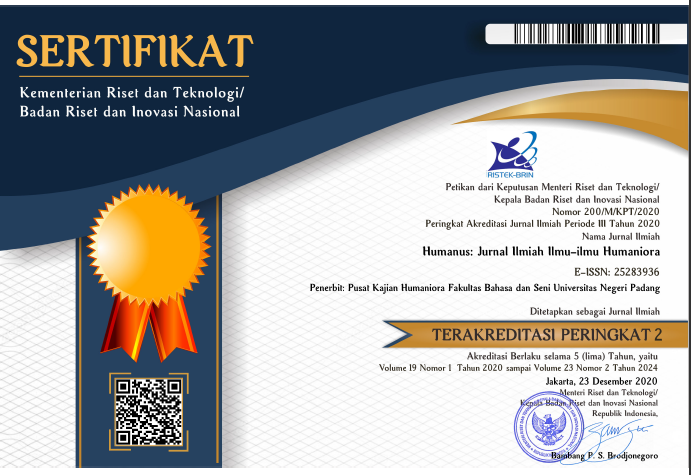The Figures and Meanings of Tengu: Semiotic Study of Mythological Creatures in Japanese Folklore
 ),
), (1) Universitas Udayana
 Corresponding Author
Corresponding Author
Copyright (c) 2020 Humanus
DOI : https://doi.org/10.24036/humanus.v19i2.109943
Full Text:
 Language : en
Language : en
Abstract
Japan is famous as an advanced manufacturing industrial country as a result of the high rationality in their works, however in daily life Japanese people still highly believe in the existence of Youkai, mythological creatures. This study examined the figures and meanings of Tengu, mythological creatures that are classified as Youkai which one of them is, as described in the Japanese folklore, having long nose and fully-red colored body. The data for this study are the folklore taken from the anthology book Nihon Mukashi Banashi 101 edited by Sayumi Kawauchi (2007). The figures and existence of Tengu in the folklore were practically analyzed using the Peirce's semiotic theory, with the focus on the meaning of icons, indexes, and symbols of Tengu in the folklore and the Japanese belief system. Moreover, this study revealed two figure types of Tengu namely daitengu, is a tengu whose long nose and kotengu whose eagle-like wings. In the Japanese belief system, it is believed that Tengu are mountain guardians, for example the Mount Takao, one of the places which is believed to be a Tengu habitat. Tengu is as well believed to have objects with supernatural powers such as kakuremino (a cloak) and ha uchiwa (a fan). The descriptions in the folklore clearly show that these Tengu actually exist, although the fact in reality is different. Regardless of either the presence or absence of these mythological creatures in the real world, furthermore, the folklore narrative shows that modern Japanese society still has a strong belief in the existence of Tengu. Stories about Tengu along with other mythological creatures continue to be passed on from a generation to another in both oral and written forms that indicates that Japanese people do not ever detach themselves from their old belief system.
Keywords
References
Ambarastuti, R. D. 2018. “Penggambaran Youkai dalam Kesusastraan Jepang dari Periode Joudai hingga Modern” in Jurnal Puitika Vol. 14 No.1 April 2018 pp. 90—98)
Balgimbayeva, N. 2019. “The Re-creation of Yōkai Character Images in the Context of Contemporary Japanese Popular Culture: An Example of the Yo-kai Watch Anime”, Mutual Images, Vol. 6, Spring 2019, pp. 21-51.
Carter, D. 2006. Literary Theory. Great Britain: Pocket Essentials.
Chandler, D. 2007. Semiotics, The Basics. London: Routledge.
Eagleton, T. 1996. Literary Theory: an introduction. London: Basic Blackwell.
Foster, M. D. 2015. The book of Yokai : Mysterious Creatures of Japanese Folklore. California: The Regents of the University of California.
Kawauchi, Y. 2007. Manga Nippon Mukashi Banashi 101. Tokyo: Kodansha.
Kusakabe, Y. (Ed). 2011. Mizuki Shigeru no Youkai Chizu: 47 Todoufuken Gotouchi Youkai o Tazuneru. Tokyo: Heibonsha.
Mizuki, S. and Murakami K. 2010. Nihon Youkai Daijiten. Tokyo: Kwai Shoten.
Nelson, A. N. 2001. Kamus Kanji Modern Jepang Indonesia. Jakarta: Kesaint Blanc.
Ross, C. 2007. Mistik Jepang. Terjemahan Tim Kretif. Supernatural and Mysterious Japan. Yogyakarta: Pinus Book Publisher.
Sari, I. A. L. 2012. “Mitos Youkai dalam Buku Kumpulan Dongeng Manga Nippon Mukashi Banashi: Youkai ga Deruzo—“. Denpasar: University of Udayana.
Shamoon, D. 2013. “The Yōkai in the Database Supernatural Creatures and Folklore in Manga and Anime”, Marvels & Tales, Volume 27, Number 2, 2013, pp. 276-289.
Shimura, K. 2008. Zusetsu Chizu to Arasuji de Yomu Nihon no Youkai Densetsu. Tokyo: Seishun.
Yamato Magazine. 2019. “How The Role Of The Tengu Has Changed In Japanese Culture” 27th Jun 2019, https://yamatomagazine.home.blog/2019/06/27/how-the-role-of-the-tengu-has-changed-in-japanese-culture/ Cited on April 25, 2020.
Yasui, M. 2017. “Depictions and Modelings of the Body Seen in Japanese Folk Religion: Connections to Yokai Images”, Advances in Anthropology, 7, 79-93. https://doi.org/10.4236/aa.2017.72006
Yoda, H. and Matt A. 2013. Yokai Attack!: The Japanese Monster Survival Guide. North America: Tuttle Publishing.
 Article Metrics
Article Metrics
 Abstract Views : 1491 times
Abstract Views : 1491 times
 PDF Downloaded : 552 times
PDF Downloaded : 552 times
Refbacks
- There are currently no refbacks.
Copyright (c) 2020 Humanus

This work is licensed under a Creative Commons Attribution-NonCommercial 4.0 International License.









